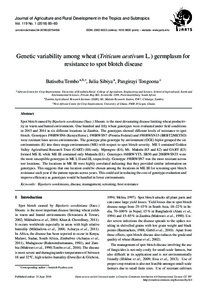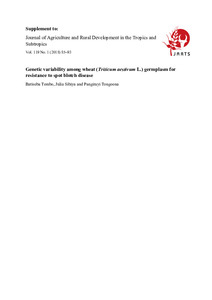Genetic variability among wheat (Triticum aestivum L.) germplasm for resistance to spot blotch disease
| dc.date.accessioned | 2018-06-26T15:25:05Z | |
| dc.date.available | 2018-06-26T15:25:05Z | |
| dc.date.issued | 2018-06-21 | |
| dc.identifier.issn | 1612-9830 | |
| dc.identifier.issn | 2363-6033 | |
| dc.identifier.uri | urn:nbn:de:hebis:34-2018022754656 | |
| dc.identifier.uri | http://hdl.handle.net/123456789/2018022754656 | |
| dc.language.iso | eng | |
| dc.publisher | Kassel University Press | ger |
| dc.rights | Urheberrechtlich geschützt | |
| dc.rights.uri | https://rightsstatements.org/page/InC/1.0/ | |
| dc.subject | Bipolaris sorokiniana | eng |
| dc.subject | disease | eng |
| dc.subject | management | eng |
| dc.subject | screening | eng |
| dc.subject | host resistance | eng |
| dc.subject.ddc | 630 | |
| dc.title | Genetic variability among wheat (Triticum aestivum L.) germplasm for resistance to spot blotch disease | eng |
| dc.type | Aufsatz | |
| dcterms.abstract | Spot blotch caused by Bipolaris sorokiniana (Sacc.) Shoem. is the most devastating disease limiting wheat productivity in warm and humid environments. One hundred and fifty wheat genotypes were evaluated under field conditions in 2013 and 2014 in six different locations in Zambia. The genotypes showed different levels of resistance to spot blotch. Genotypes 19HRWSN6 (Kenya Heroe), 19HRWSN7 (Prontia Federal) and 19HRWSN15 (BRBT2/METSO) were resistant lines across environments. The genotype plus genotype by environment (GGE) biplot grouped the six environments (E) into three mega-environments (ME) with respect to spot blotch severity. ME I contained Golden Valley Agricultural Research Trust (GART) (E6) only. Mpongwe (E4), Mt. Makulu (E5 and E2) and GART (E3) formed ME II, while ME III contained only Mutanda (E1). Genotypes 16HRWYT5, SB50 and 20HRWSN33 were the most susceptible genotypes in ME I, II and III, respectively. Genotype 19HRWSN7 was the most resistant across test locations. The locations in ME III were highly correlated indicating that they provided similar information on genotypes. This suggests that one location could be chosen among the locations in ME III for screening spot blotch resistance each year if the pattern repeats across years. This could aid in reducing the cost of genotype evaluation and improve efficiency as genotypes would be handled in fewer environments. | eng |
| dcterms.accessRights | open access | |
| dcterms.bibliographicCitation | In: Journal of Agriculture and Rural Development in the Tropics and Subtropics. Kassel : Kassel University Press. - Vol. 119, No. 1 (2018) S. 85-93 | |
| dcterms.creator | Tembo, Batiseba | |
| dcterms.creator | Sibiya, Julia | |
| dcterms.creator | Tongoona, Pangirayi | |
| dc.description.everything | Gedruckte Ausg. im Verlag Kassel Univ. Press (www.upress.uni-kassel.de) erschienen. | ger |
Files in this item
This item appears in the following Collection(s)
-
Vol 119, No 1 (2018) [11]


